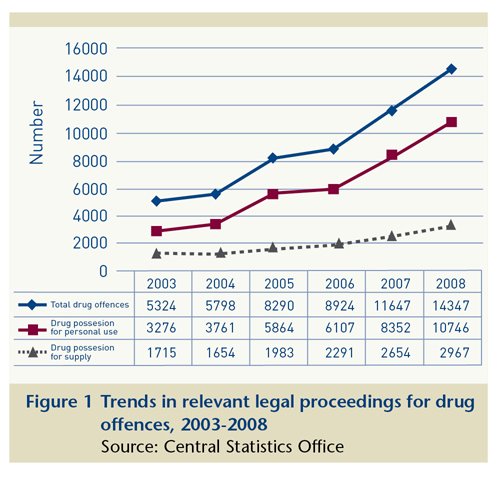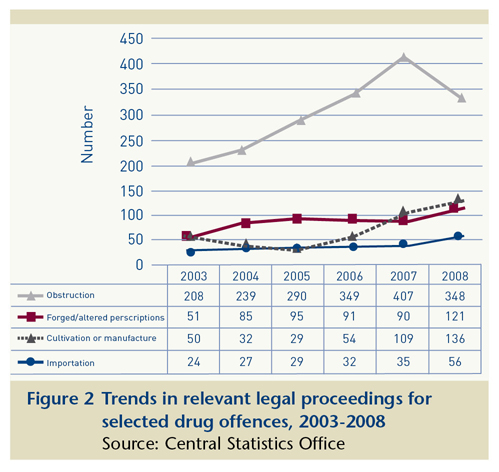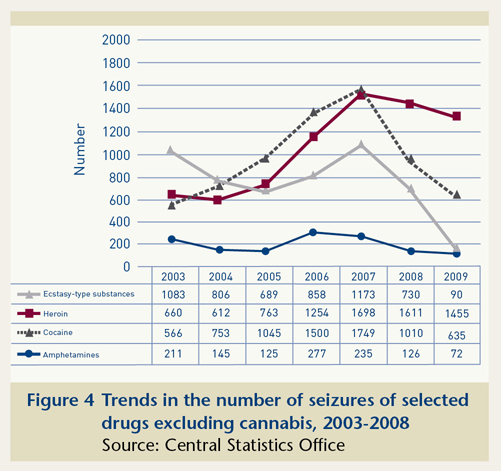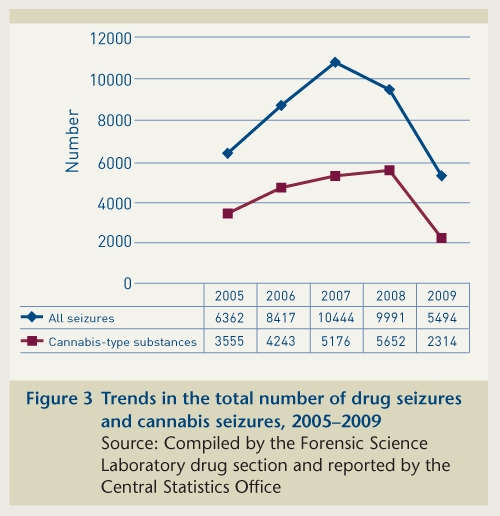Connolly, Johnny (2011) Drug-related crime statistics. Drugnet Ireland, Issue 36, Winter 2010, pp. 23-24.
| Preview | Title | Contact |
|---|---|---|
|
PDF (Drugnet Ireland, issue 36)
- Published Version
688kB |
In 2006, responsibility for reporting crime statistics was transferred from the Garda Síochána to the Central Statistics Office (CSO). The vast majority of drug offences reported come under one of three sections of the Misuse of Drugs Act (MDA) 1977: section 3 – possession of any controlled drug without due authorisation (simple possession); section 15 – possession of a controlled drug for the purpose of unlawful sale or supply (possession for sale or supply); and section 21 – obstructing the lawful exercise of a power conferred by the Act (obstruction). Other MDA offences regularly reported on relate to the unlawful importation into the State of controlled drugs contrary to section 21; permitting one’s premises to be used for drug supply or use contrary to section 19; the use of forged prescriptions (section 18); and the cultivation of cannabis plants (section 17).

Figure 2 shows trends in legal proceedings for a selection of other drug offences between 2003 and 2008. Although the offence of obstructing the lawful exercise of a power conferred by the Misuse of Drugs Act 1977 (s.21) continues to be the largest category, proceedings for such offences decreased in 2008, following a steady increase since 2003. Obstruction offences often involve an alleged offender resisting a drug search or an arrest or attempting to dispose of drugs to evade detection. In 2008 there was an increase in the number of proceedings for drug importation and forging a prescription to obtain drugs in a pharmacy. Proceedings for the cultivation or manufacture of drugs continued to increase, rising from 29 in 2005 to 136 in 2008. It is unclear whether this increase reflects a genuine growth in the commission of such offences or a greater concentration of law enforcement on detecting them.

Drug seizures
The data presented looks at trends in the number of drugs seized by law enforcement (Revenue Customs Service and An Garda Síochána) and analysed and reported by the Forensic Science Laboratory (FSL). It should be noted that not all drugs seized by law enforcement are necessarily analysed and reported by the FSL. For example, if no individual is identified in relation to the drug seizure, and no prosecution takes place, the drugs may not be sent for analysis and may be destroyed. In other circumstances, there may be some large cannabis/cannabis resin cases without a suspect where no analysis is conducted and no quantification (purity determination) is carried out.
The reduction in the total number of reported seizures in 2009 shown in Figure 3 may also be explained by a reduction in the number of seizures of other drugs since 2008. Figure 4 shows trends in seizures for a selection of drugs, excluding cannabis, between 2003 and 2009. There has been a significant decline in cocaine, heroin and ecstasy-type substances seized since 2007. In 2007 there were 1,173 ecstasy-type substances seized, in 2009 this figure was 90; in 2007 there were 1,749 cocaine seizures, while in 2009 there were 635 cocaine seizures. In 2007 there were 1,698 heroin seizures while in 2009 there 1,455 heroin seizures. It appears, then that the significant reduction in total drug seizures reported in 2009 can be explained primarily as the result of a reduction in seizures of cannabis and cocaine.

Repository Staff Only: item control page
